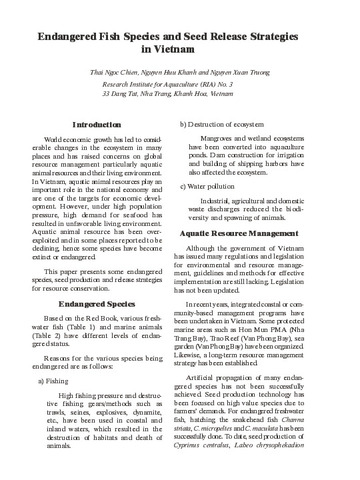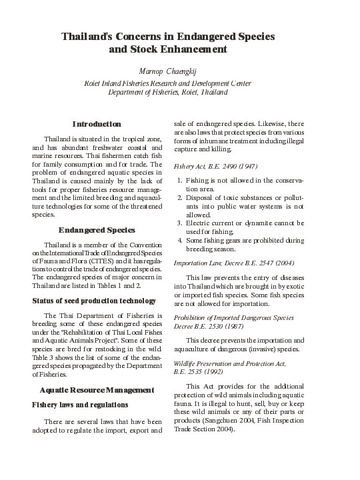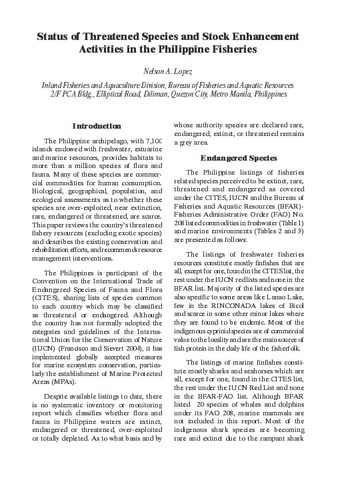| dc.contributor.author | Sayan, Suwanee | |
| dc.contributor.author | Wanchana, Worawit | |
| dc.contributor.author | Kissol Jr., Lawrence | |
| dc.contributor.author | Sulit, Virgilia T. | |
| dc.date.accessioned | 2019-10-03T06:02:43Z | |
| dc.date.available | 2019-10-03T06:02:43Z | |
| dc.date.issued | 2019 | |
| dc.identifier.citation | Sayan, S., Wanchana, W., Kissol Jr., L., & Sulit, V. T. (2019). Developing the regional position on proposed inclusion of commercially-exploited aquatic species into CITES appendices: The Southeast Asian Region under the spotlight. Fish for the People, 17(2), 2-9. | en |
| dc.identifier.uri | http://hdl.handle.net/20.500.12066/5521 | |
| dc.description.abstract | The Convention on International Trade in Endangered Species of Wild Fauna and Flora (CITES) which was entered into force on 1 July 1975, is an international agreement among governments (also known as Parties) with the objective of ensuring that international trade in specimens of animals and plants does not threaten their survival in the wild. Specifically for the commercially exploited aquatic species (CEAS), CITES sets the criteria and guidelines for making decisions as to whether or not a certain CEAS should be listed into the CITES Appendices. The listing of some species of CEAS in the CITES Appendices on the one hand, could have certain impacts not only on the management of the fisheries of the species but also on the economies of many countries of the Southeast Asian region that have been catching and trading some of the species and their “look-alikes” as well as trading in parts of their processed forms. On the other hand, the inclusion of any CEAS in the CITES Appendices would serve as means of addressing the concerns with regards to the conservation and management of such species. The Parties to CITES, referred to as the Conference of the Parties (CoP), meet every two to three years mainly to review the progress in the conservation of the species included in the CITES Appendices, and consider the proposals to amend the lists of species in Appendices I and II or to list new species in the Appendices. To equip the Southeast Asian countries with the necessary justifications with respect to the proposals for listing certain CEAS in the Appendices, which the countries could also use as reference during the voting at the meetings of the CITES CoP, the Southeast Asian Fisheries Development Center (SEAFDEC) regularly organizes regional technical consultations (RTCs) to discuss the possible impacts of the proposals on the fisheries of such species, and develop the common or coordinated position of the SEAFDEC Member Countries on such proposals. Implemented as part of the SEAFDEC collaborative project “Assistance for Capacity Building in the Region to Address International Fish Trade-related Issues,” which receives generous financial support from the Government of Japan Trust Fund (JTF), the RTCs also aspire to come up with recommendations on the issues related to the conservation and sustainable utilization of such CEAS which the countries could also raise during the CITES CoP. | en |
| dc.language.iso | en | en |
| dc.publisher | Secretariat, Southeast Asian Fisheries Development Center | en |
| dc.subject | South East Asia | en |
| dc.title | Developing the regional position on proposed inclusion of commercially-exploited aquatic species into CITES appendices: The Southeast Asian Region under the spotlight | en |
| dc.type | magazineArticle | en |
| dc.citation.volume | 17 | |
| dc.citation.issue | 2 | |
| dc.citation.spage | 2 | |
| dc.citation.epage | 9 | |
| dc.citation.journalTitle | Fish for the People | en |
| dc.subject.asfa | international agreements | en |
| dc.subject.asfa | commercial species | en |
| dc.subject.asfa | rare species | en |
| dc.subject.asfa | nature conservation | en |
| dc.subject.asfa | Protected resources | en |
| dc.subject.asfa | resource conservation | en |
| dc.subject.asfa | trade | en |
| dc.subject.asfa | resource management | en |




